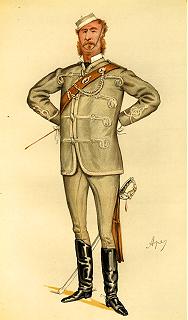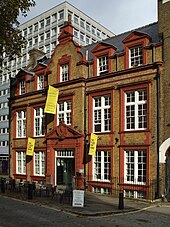Robert William Edis
Colonel Sir Robert William Edis | |
|---|---|
 "Architecture Militant", caricature of Edis by "Spy" (1885) | |
| Born | Robert William Edis 13 June 1839 |
| Died | 23 June 1927 (aged 88) |
| Education | Huntingdon Grammar School Aldenham School |
| Spouse | Elizabeth Ann Woodward |
| Children | 5 |
| Relatives | Isabella Reaney (sister) Olive Edis (niece) |
Colonel Sir Robert William Edis KBE CB DL JP (13 June 1839 – 23 June 1927) was a British architect.[1][2]
Early life
Edis was born in Huntingdon to Emma and Robert Edis, also an architect.[3] His sister was the preacher Isabella Reaney,[4] his brother was Arthur Wellesley Edis, a gynaecologist,[5] and his niece through Arthur was the photographer Olive Edis.[6]
Edis was educated at Huntingdon Grammar School and Aldenham School, before attending University College School in London and studying at the Royal Academy Schools.[3] He was then articled to William Gilbee Habershon and Edward Habershon, architects, in London.[1][2]
Career

He became chief assistant to Anthony Salvin, and joined the Architectural Association in 1859.[1] He was admitted an Associate of the Royal Institute of British Architects in 1862 and a fellow of the association in 1867.[1]
Although his early work was Gothic, Edis later became a proponent of the Queen Anne style of baroque revival architecture. He worked mostly on private houses and public buildings, although he did design a few churches.[7]
He later became involved in the Aesthetic Movement of decorative arts and in furniture design, and delivered a series of Cantor lectures on the subject at the Royal Society of Arts. These formed the basis of two books: Decoration and Furniture of Town Houses (1881) and Healthy Furniture and Decoration (1884).[1][8] Combining principles of Aestheticism with the Sanitary Movement, Edis delivered a lecture during the 1884 International Health Exhibition calling for more artistic designs within hygienic interior objects.[9]

From 1883, Edis extended and rebuilt Sandringham House in Norfolk for the Prince of Wales.[10][11] He was the designer of the parish hall and parsonage for St Philip's Church, Buckingham Palace Road (1892) and the British pavilion at the World's Columbian Exposition in Chicago (1893).[citation needed]
He built a studio on Church Street, Sheringham, for his nieces the photographers Olive and Katharine Edis. It was their first studio and had a glass roof to allow in natural daylight which became an important aspect of their trademark style.[6]
Edis had a long association with the Volunteer Force and its successor the Territorial Force. In 1868 he received a commission in the Artists' Rifles.[12] He went on to be the regiment's commanding officer from 1883 to November 1902,[13][14][15] and subsequently held the office of honorary colonel from 1902 until his death (he continued when the regiment was reorganized as part of the Territorial Force in 1908).[2][16] He designed the unit's drill hall at Duke's Road, off Euston Road, Camden (now The Place, home of the Contemporary Dance Trust).[17]
In January 1889 he was elected a member of the first London County Council, representing St Pancras South for three years as a member of the Conservative-backed Moderate Party.[18]
Personal life
In 1863, Edis married Elizabeth Ann Woodward.[3] He had homes at Ormesby Old Hall, Great Ormesby, Norfolk, as well as Fitzroy Square[19] and Regent's Park, London.[20] He was a justice of the peace and a Deputy Lieutenant for Norfolk from 1901.[2][21] He was created a Knight Commander of the Order of the British Empire in 1919 for his military services.[22]
Edis died suddenly at his Norfolk home in 1927, aged 88.[2] He was predeceased by his wife, but was survived by his five daughters.[23]
References
- ^ a b c d e Clerkin, Paul. "Edis, Sir Robert William (1839–1927)". Archiseek. Retrieved 25 March 2012.
- ^ a b c d e "Obituary: Sir R. W. Edis". The Times. 25 June 1927. p. 14.
- ^ a b c Gardens (en), Parks and. "Mr Robert William Edis". www.parksandgardens.org. Parks & Gardens. Retrieved 30 October 2024.
- ^ "Reaney [née Edis], Isabella Emily Thomasa [Isabel] (1847–1929), preacher and social activist". Oxford Dictionary of National Biography (online ed.). Oxford University Press. 2004. doi:10.1093/ref:odnb/56693. Retrieved 29 June 2020. (Subscription or UK public library membership required.)
- ^ Neale, Shirley (1 November 1996). "Arthur Wellesley Edis (1840–1893): Obstetrician and Gynaecologist". Journal of Medical Biography. 4 (4): 200–207. doi:10.1177/096777209600400403. ISSN 0967-7720. PMID 11618388. S2CID 26815834.
- ^ a b Olive Edis; Alistair Murphy; Elizabeth Elmore (2017). Fishermen & kings: the photography of Olive Edis (Second ed.). Norwich. ISBN 978-0-903101-88-2. OCLC 1137104261.
{{cite book}}: CS1 maint: location missing publisher (link) - ^ "Architects and Artists D-E". Sussex Parish Churches. A primary source of information on churches in East and West Sussex. Archived from the original on 8 November 2011.
- ^ "Robert William Edis". Designer Biographies. Haslam and Whiteway. Retrieved 25 March 2012.
- ^ International Health Exhibition (1884). The Health Exhibition literature. London: Printed and published for the Executive Council of the International Health Exhibition, and for the Council of the Society of Arts, by William Clowes and Sons.
- ^ Jenkins, Simon (2003). England's Thousand Best Houses. London: Penguin Books. p. 530. ISBN 978-0-713-99596-1.
- ^ Pevsner, Nikolaus; Wilson, Bill (2002). Norfolk 2: North-West and South. The Buildings Of England. New Haven, US and London: Yale University Press. p. 627. ISBN 978-0-300-09657-6.
- ^ "No. 23346". The London Gazette. 24 January 1868. p. 340.
- ^ "No. 25251". The London Gazette. 17 July 1883. p. 3588.
- ^ "Naval & Military intelligence". The Times. No. 36941. London. 3 December 1902. p. 7.
- ^ "No. 27508". The London Gazette. 23 December 1902. p. 8848.
- ^ "No. 28287". The London Gazette. 10 September 1909. p. 6815.
- ^ Historic England. "The Place and attached railings, Camden (1342089)". National Heritage List for England.
- ^ "The County Councils – London Polls". The Times. 18 January 1889. p. 9.
- ^ "Fitzroy Square Pages 52-63 Survey of London: Volume 21, the Parish of St Pancras Part 3: Tottenham Court Road and Neighbourhood. Originally published by London County Council, London, 1949". British History Online. Retrieved 4 August 2020.
- ^ Brodie, Antonia (2001). Directory of British Architects 1834–1914: A-K. p. 588. ISBN 9780826455130.
- ^ "No. 27323". The London Gazette. 14 June 1901. p. 4005.
- ^ "No. 31395". The London Gazette. 16 June 1919. p. 7426.
- ^ "Sir Robert W. Edis (1839-1927)". www.archiseek.com. Architecture @ Archiseek.com. Retrieved 30 October 2024.
